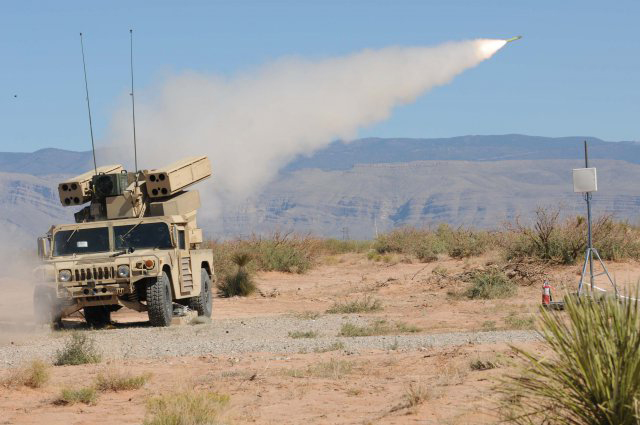
Soldiers from 2nd Battalion, 263rd Air Defense Artillery, South Carolina National Guard, send a stinger missile downrange from the Humvee-mounted Avenger missile system at Range 91 near Oro Grande, N.M., Oct. 23, 2011. Source: US Army.
The main air defense system at a coalition base in northeastern Syria was “not fully operational” when the installation was struck by a suspected Iranian drone, The New York Times reported on March 24, citing two U.S. officials.
A U.S. contractor was killed and five U.S. service members and a second U.S. contractor wounded as a result of the attack that took place on March 23.
One U.S. official told The New York Times that the AN/TWQ-1 Avenger at the RLZ base, which is located near the city of al-Hasakah, may have been experiencing a maintenance problem at the time of the attack.
The Avenger was developed by Boeing to provide mobile, short-range air defense protection against cruise missiles, drones as well as low-flying aircraft. The system’s main armament is the FIM-92 Stinger infrared homing missile, which has a range of up to five kilometers. The U.S. deployed several such systems in its bases in Syria a few years ago.
From his side, Brigade General Patrick Ryder, a spokesman for the Pentagon, said that the air defense’s radar was working. However, he declined to discuss any other details of the system, citing operational security and an investigation by the military’s Central Command.
Asked how the drone was able to hit the base even with the radar working, Ryder shifted blame to Iranian-backed forces in Syria.
“This is a dangerous part of the world. The work that we do is inherently dangerous, that’s why you have the military in these types of places conducting these types of operations,” Ryder said. “CENTCOM will do an assessment in terms of the attack. But the fact is that these IRGC [Islamic Revolutionary Guard Corps] backed groups conducted this attack and unfortunately, we had an American killed.”
He also would not say if there was an effort to shoot down the drone, only saying that “we take a variety of measures to safeguard our people.”
Other U.S. officials stated that it is still unclear whether the attackers had detected that vulnerability and exploited it or just happened to send the drone at that time, according to The New York Times.
The U.S. Central Command launched strikes against facilities used by forces affiliated with the IRGC in different parts of Deir Ezzor some 13 hours after the drone strike. At least 14 were killed or wounded as a result of the strikes.
Iranian-backed forces responded to the strikes by firing rockets at the coalition’s Green Village base in the al-Omar oil fields in the southeastern Deir Ezzor countryside. The next day, March 24, the forces attacked the same base with suicide drones. They also fired rockets at the Conoco gas plant in the eastern Deir Ezzor countryside where U.S. troops are deployed. At least one service member was wounded.
The situation in northeastern Syria is currently calm. However, a new round of clashes could break out if the U.S. attempted to respond to the recent attacks on the Green Village and Conaco.
MORE ON THIS TOPIC:






Or… Was it just that US air defence systems like the very expensive “patriot system” are just junk?
Weakest air defense system in the world, it was only NATO that helped Ukrainian air defenses a little, but I still wonder why isn’t Russia using its fighter jets enough?
No need to, America is imploding along with the EU. No hurry
Completely is more important. North America can survive as ‘an island nation’ while Europe goes through a needed transition.
Dobrá práca!!! Netreba v nej poľavovať. Treba si takéto úspechy zopakovať. Okupantov treba vybiť do posledného, alebo ich vyhnať zo Sýrie!!!
Just more overrated, over priced, US dollar laundered junk
The dog ate my homework usually works for US defensive failures. Or they may want a body count to justify further escalation.
“Avenger” is almost useless even fully operational. It can’t destroy planes at medium altitude and higher, can’t destroy large ballistic missiles even with direct hit, because its warhead too small against several ton rockets. ADATS is a bit better, but a way worse than obsolete “Tunguska”, not saying about “Pantzir’-S” and especially SM. Next time Syria may use “Tochka” or “Iskander”, and nothing will save base of illegal occupiers.
“contractors” profiteering monie grabbing defense contractors, who cares. They all know their there illegally.
The AD was destroyed by Kamikaze drones.
. . . nor on 9/11. Just sayin, . . . .
More US junk that broke down should send it to the 🤡 in keiv.